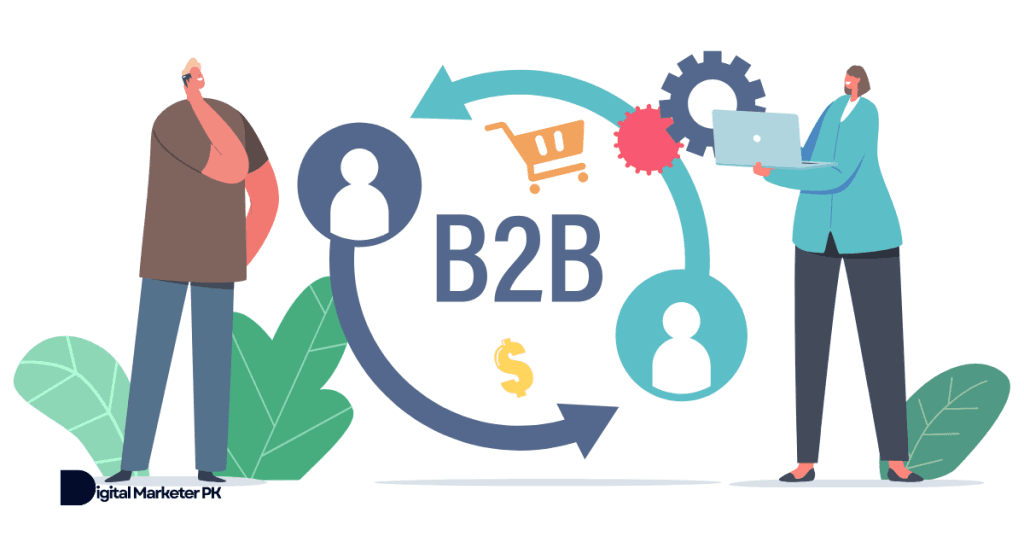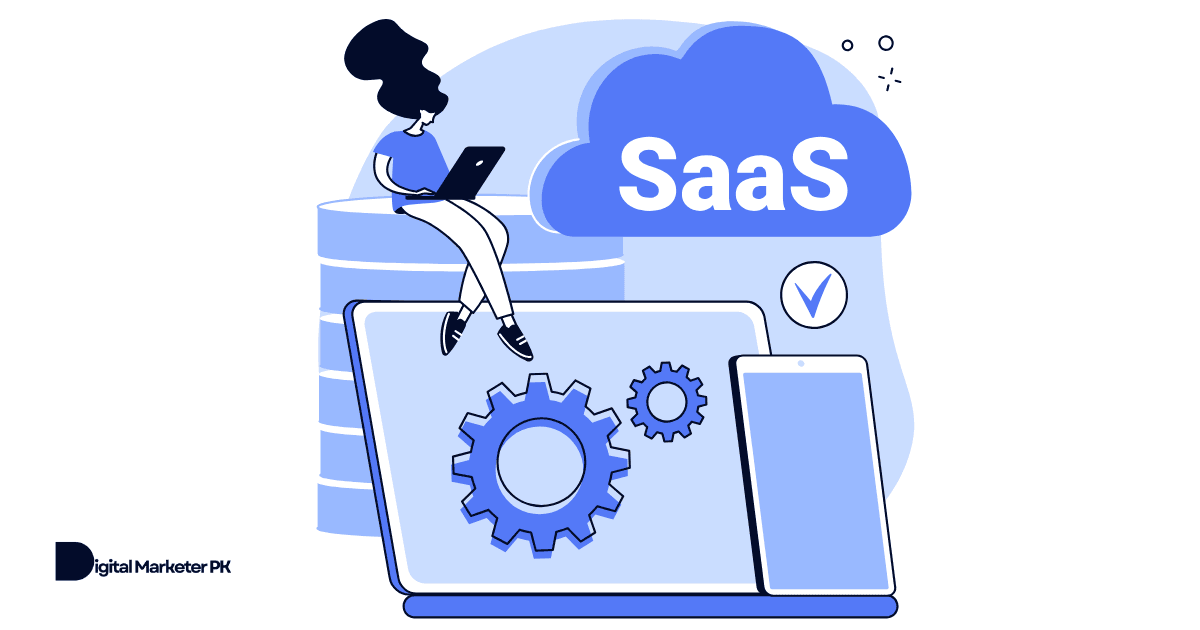This B2B SaaS SEO guide is for SaaS companies that want to increase organic traffic and improve search rankings.
More than 90% of all online interactions start with a search engine and around 80% of online searches have unbranded terms.
It’s time you start using search engines to generate leads for your B2B SaaS business.
Here’s how…
What is B2B SaaS SEO?
The B2B SEO for SaaS is the process of increasing the search visibility of a software company to attract target businesses from search engines. SEO techniques are geared towards generating organic traffic from businesses that are interested in buying your software.
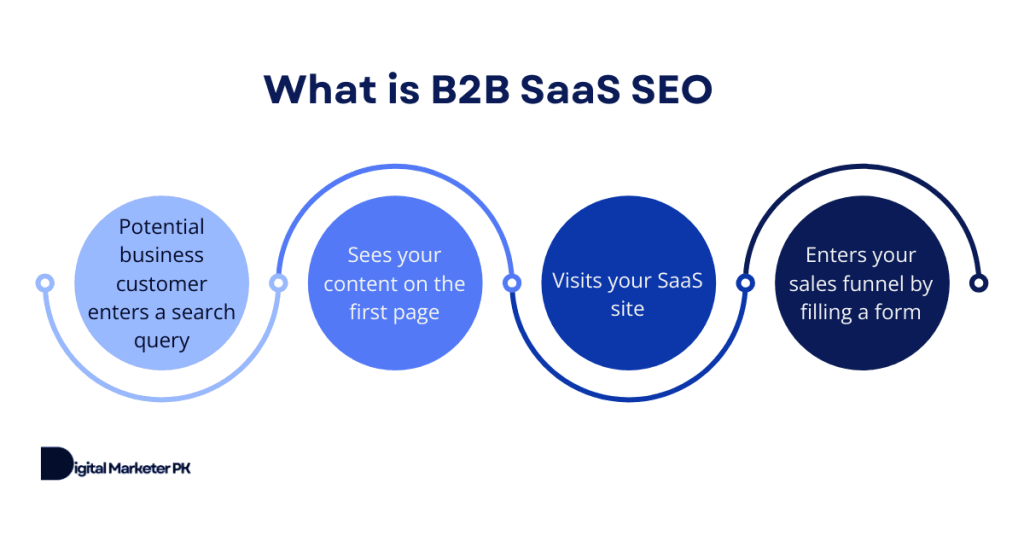
It involves on-page, off-page, and technical SEO to improve the crawling, indexing, and ranking of your B2B SaaS company. You get access to:
- Better search visibility
- Higher rankings in search engines
- More organic traffic
- Improved brand awareness and trust
- Lower customer acquisition cost
- Better reach
- Thought leadership.
B2B vs B2C SEO for SaaS: What’s the Main Difference?
How you approach SEO for a B2B SaaS company differs from that of a B2C SaaS business. The major differences between the two are:
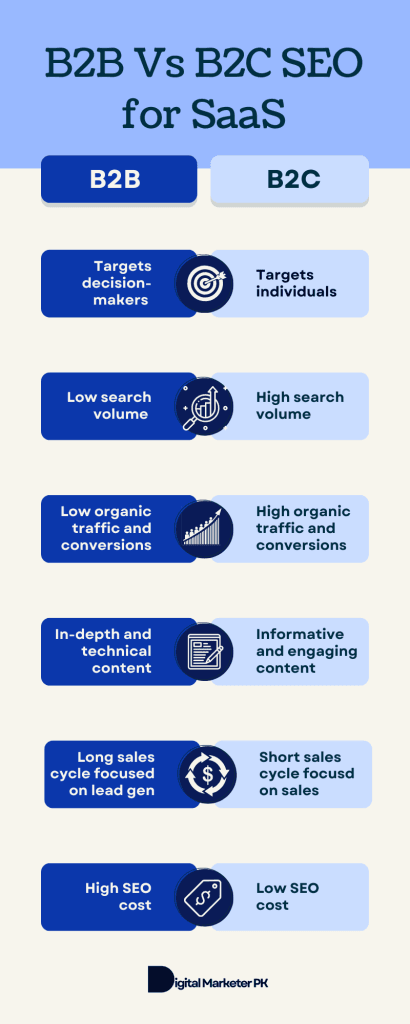
Target Audience
You need to target decision-makers in B2B SaaS SEO while in the case of B2C, you target individuals irrespective of where they work.
Targeting B2B audiences means you have to create content that addresses multiple types of queries for different positions. A single article per keyword isn’t usually enough.
For instance, if you have a B2B finance app, you’ll target the entire finance team including CFO, managers, assistants, and more. This means you have to target a series of keywords to reach a target group.
This isn’t the case with B2C SaaS SEO where you target an individual which is quite easier. Selecting and targeting keywords that potential customers use is quite easy.
Search Volume
B2B keywords have a low search volume as compared to B2C keywords.
Generally, B2B keywords have low monthly search volumes. This is because you are dealing with multiple decision-makers and the sales process is usually very long.
The initial search for new software for a business might start from a search engine, but the deal is finalized and closed by the sales team. An average B2B sales cycle consists of 102 days. This doesn’t involve repeated searches on Google or Bing. A potential client might run a search, find top software, and will never run a search query again.
B2C keywords have massive search volume because the sales cycle is shorter and conversion takes place without the involvement of a salesperson.
For instance, air conditioner has more than 100K monthly searches in the US while commercial air conditioner has around 10K monthly searches in the US.
This means you can drive massive traffic by targeting B2C keywords due to high search volume. On the flip side, B2B keywords drive less traffic and you might be competing for a few hundred monthly visitors with hundreds of competitors.
Traffic and Conversions
B2B SEO for SaaS drives low traffic and fewer conversions as compared to B2C SaaS SEO.
When you target keywords with low monthly search volume for your B2B SaaS company, you’ll receive fewer organic visitors per month. Low traffic means low conversions.
However, low conversions don’t mean low profit. You might make a few thousand dollars per client for your B2B app.
When you target B2C keywords for your SaaS business, you’ll receive heaps of organic traffic and lots of conversions. Since visitors usually don’t need to talk to a sales rep to complete their purchase, they can register and start using your platform instantly. This leads to a high conversion rate.
Content
The content you create for B2B SaaS SEO is more in-depth and technical while content for B2C SaaS companies is more informative and engaging.
Businesses need technical content that addresses their specific needs in detail such as whitepapers and technical articles. They look for authority and thought leadership as they have to engage in a business transaction with your SaaS company.
B2C content for SEO is geared towards information and solving problems. This includes blog posts and social media posts. You need to create content that addresses key individual challenges and provides solutions.
How you pursue content marketing for B2B vs B2C has a major impact on SaaS SEO.
Metrics
The metrics and KPIs you use to monitor the SEO performance of B2B SaaS are quite different from B2C SEO.
For B2B SaaS SEO, you need to look at metrics like conversion rate, qualified leads, marketing qualified leads (MQL), customer lifetime value, pipeline velocity, sales qualified leads (SQL), MQL vs. SQL, etc.
The metrics for B2C SaaS SEO include conversion rate, organic traffic, customer acquisition cost, customer lifetime value, retention rate, cost per acquisition, etc.
Cost
The cost of B2B SaaS SEO is much higher than B2C SaaS SEO.
Since B2B SEO for a SaaS company requires more detailed content and the sales cycle is quite long, it leads to a high cost. You have to spend a lot of time on leads to nurture them which costs a lot of resources.
B2C SEO for SaaS focuses on publishing quality, informative content that doesn’t cost you a lot. Due to a shorter sales cycle and as conversions take place automatically on your site, you don’t need to have a sales team for lead nurturing.
The average order value is quite high for B2B as compared to B2C. High SEO cost doesn’t necessarily mean a low profit margin.
How to Create a B2B SaaS SEO Strategy
Here’s a step-by-step actionable guide to developing a B2B SaaS SEO strategy:
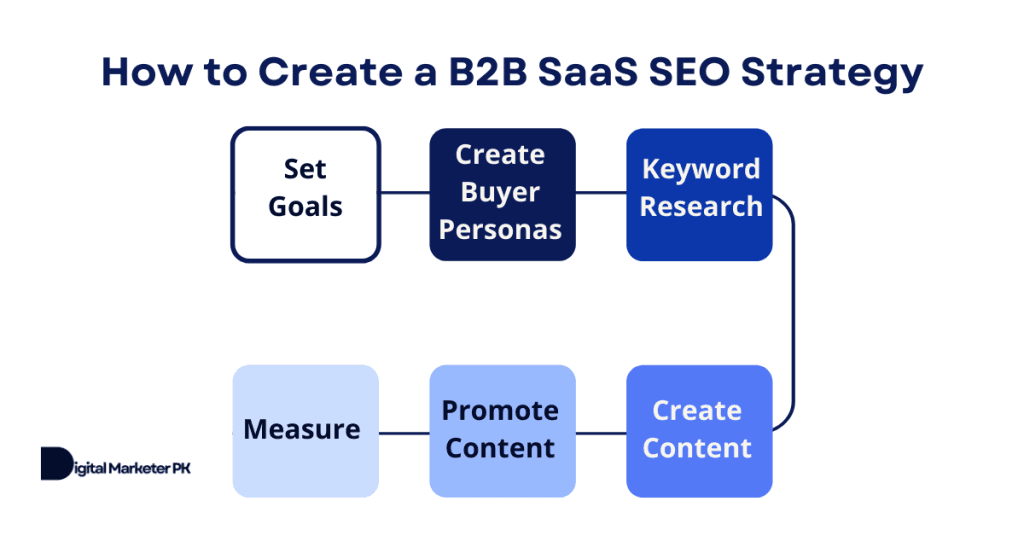
1. Set Goals
The first step is setting goals and objectives for your SEO strategy. You should be clear on what you want to achieve with SEO for your B2B SaaS business.
- Is it more organic traffic
- Brand awareness
- Authority and thought leadership
- More leads
- Building relationships with potential clients.
Choosing a goal helps you in setting a clear and correct path of action to achieve it. Your goal isn’t constant as it keeps changing.
For instance, you might want to double organic traffic in Q1-Q2 2025 and then switch to generating 10K leads in 6 months for Q3-Q4 2025.
The best way to set a realistic and achievable goal for B2B SaaS SEO strategy is through the SMART goal framework that focuses on creating Specific, Measurable, Achievable, Relevant, and Timely goals:

The most common types of goals for B2B SEO for a SaaS brand include lead generation, brand awareness, and authority. B2B businesses don’t focus too much on organic traffic and conversions (which tend to be common goals for B2C SaaS companies) as they have to spend time on the lead nurturing process.
Use the SMART goal technique to identify and list SEO goals for your strategy. Read more about SMART goals and example of a SMART goal here.
2. Create Buyer Personas
A customer or buyer persona is an essential element for your B2B SaaS SEO strategy because it tells you who your target audience is.
As a B2B SaaS business, you have to reach different target groups with diverse challenges and interests. For instance, for a CRM tool, you’ll need to target executives, marketers, salespersons, customer operation heads, HR teams, founders, and others across different sectors you target. It’s really hard to send all of them to a single (all-in-one) landing page and expect a high conversion rate.
This is where you need buyer personas that help you tweak your offer, landing page, and copy based on the specific needs of the target market. The more customized your offer is, the better.
Check the following examples of different landing pages Zoho uses to target different buyer personas:

Precise targeting like this can be done via buyer personas. Here’s an example of what a customer persona looks like:

The development of a buyer persona has two core prerequisites:
- Identify your target market and audience
- Collect data (both primary and secondary) that includes demographics, behavior, psychographics, and others.
Once you have these, the rest is easy.
You need to choose a buyer persona template and fill in the details. Here’s a list of the essential questions that a buyer persona should answer:
- Who is your ideal customer?
- Role and education
- Biggest professional challenges
- Interests and hobbies
- Where they hunt for software they need for their company.
3. Keyword Research
A robust keyword strategy is an important part of your B2B SaaS SEO strategy.
There are a few different ways to find keywords for your B2B company:
- Use existing data (e.g., Google Analytics and Search Console)
- Use buyer personas to find what keywords your ideal customers use
- Analyze competitors using a tool like SpyFu or Semrush and see what keywords they are targeting and how much traffic they are receiving for those keywords
- Use keyword research tools like Ahrefs.
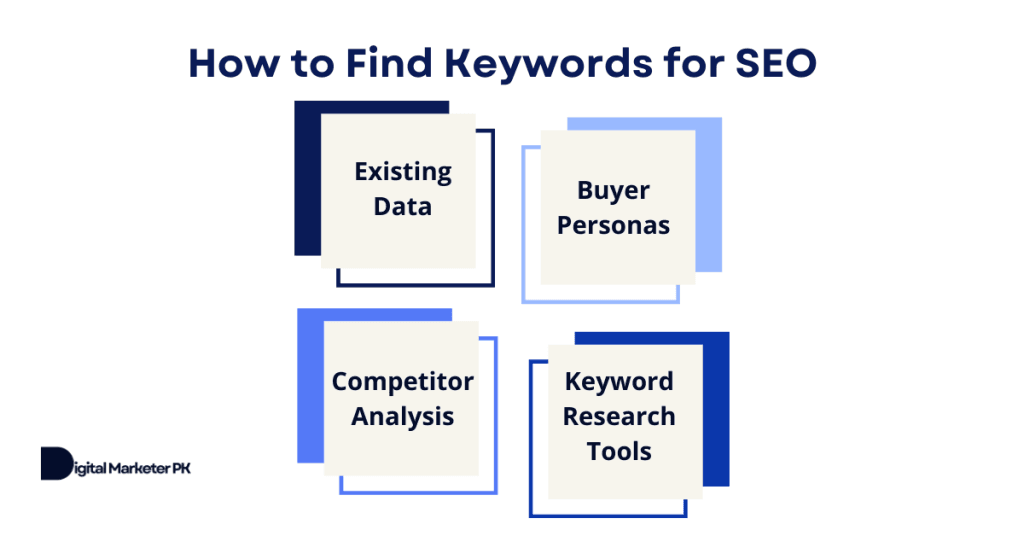
Here’s how you should start the keyword research process:
- Identify seed keywords
- Find relevant keywords for targeting
- Link keywords to search intent and sales funnel
- Create a list of relevant topics
- Prioritize topics.
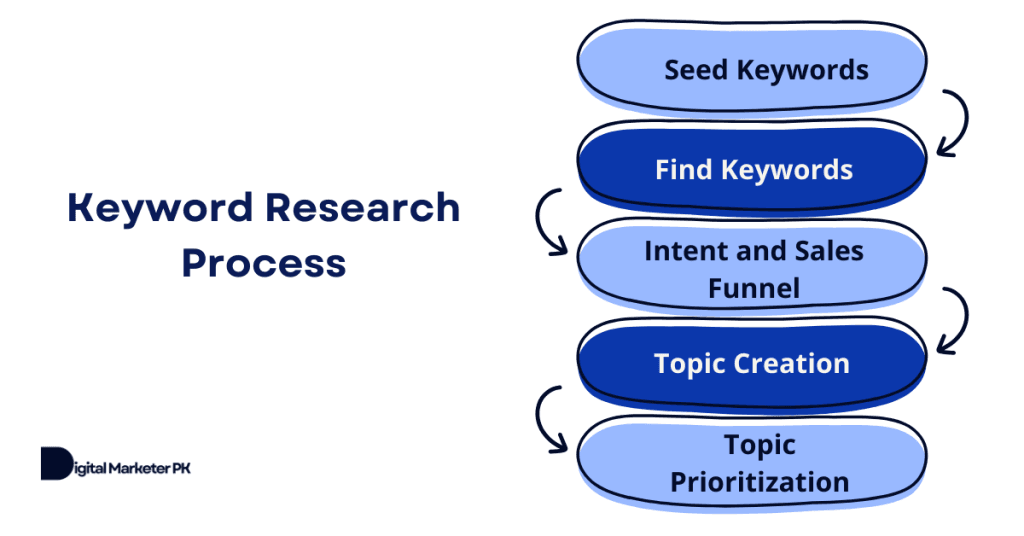
1. Identify Seed Keywords
A seed keyword is the foundational words or phrases that are directly related to your business and represent your SaaS company. Seed keywords are used to generate more specific keywords and keyword ideas.
You need a starting word or phrase to begin the keyword research process, these are seed keywords.
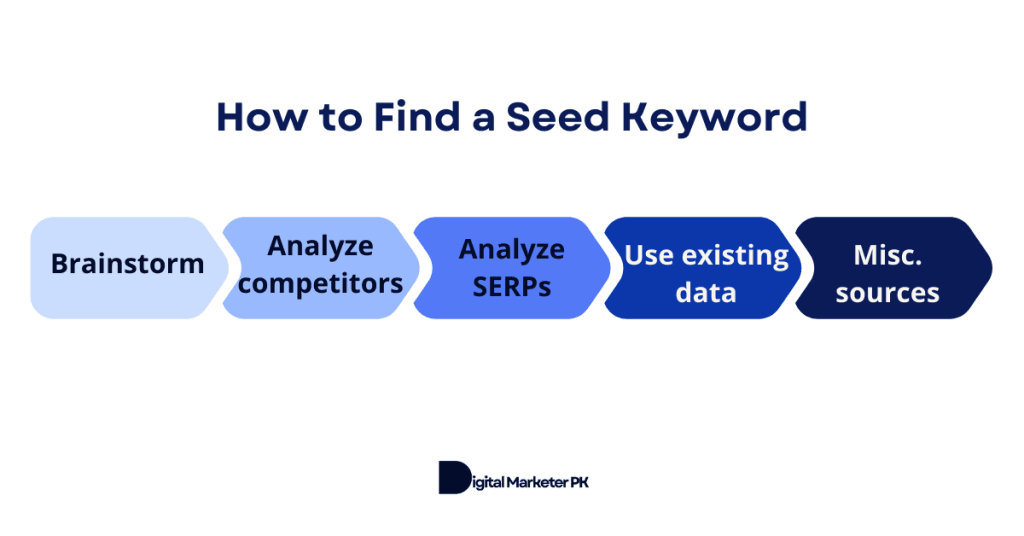
For instance, CRM software is a seed keyword that you plug into a keyword research tool to find a series of related keywords including short and long tails.
Related keywords include what is CRM software, CRM software for small businesses, best CRM software, free CRM platform, and several others.
You need to find seed keywords for your SaaS company. Here’s how you can do it:
- Brainstorm
- Analyze competitors
- Analyze search results
- Look at your Google Analytics and Search Console to find what words and phrases your site is already ranking for
- Get ideas from social media, hashtags, forums, etc.
Identify all the seed keywords for your B2B SaaS company and list them in an Excel sheet.
2. Find Keywords
You need to use seed words to find keywords for SEO. Seed keywords are general phrases that aren’t the keywords you want to rank for.
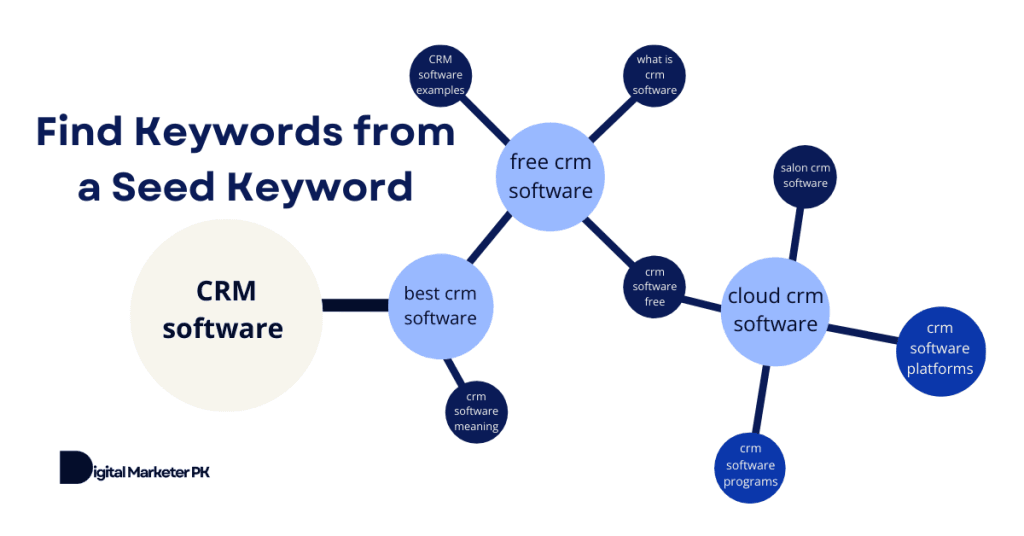
The idea is to extract keywords from seed keywords and list them in the Excel sheet. You need a keyword research tool to find keywords such as Google Keyword Planner (free) or Ahrefs (paid).
When listing keywords, add monthly search volume and keyword difficulty.
Screen keywords and choose ones that are relevant to your SaaS business, have search volume and have low to medium keyword difficulty (which means you can rank for them easily depending on your domain authority).
Not all keywords are worth targeting so make sure you pick keywords that are valuable for your SaaS company.
3. Search Intent and Sales Funnel
Search intent is the reason why a user enters a search query in the search engine. It is essential to understand the intent of the keywords you plan to target.

Intent helps you address queries precisely in the content. You’ll tackle informational intent differently than transactional intent. The same goes for the sales funnel stage.
The content needs of someone who is at the top of the funnel are different from someone who has moved to the bottom of the funnel.

You need to align keywords to the right search intent and the funnel stage to ensure you create content that’s relevant to the searcher.
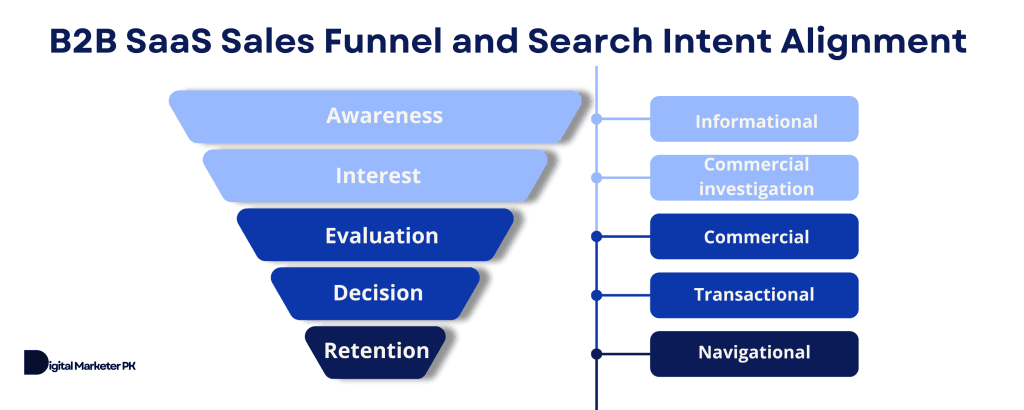
Add search intent and funnel stage to target in the Excel sheet.
4. Create Topics
Creating topics means you have to group similar keywords (based on their intent and funnel stage). This will help you target a group of keywords with a single topic.
Consider the following keywords:
- Best CRM tool
- Top CRM software
- CRM platforms
- Best CRM apps
These are all similar keywords that have the same search intent (informational) and target people who are at the top of the funnel. You don’t have to create content for these keywords separately, rather you can target them with a single article.

Create topics by combining similar keywords and each topic will act as an article idea for your blog.
5. Prioritize Topics
You need to prioritize topics based on their value for your business.
Priority can be set in three ways:
- Traffic potential (topics that have high monthly search volume)
- Ranking potential (topics that are easy to rank)
- Business potential ((highly profitable and essential topics for your B2B SaaS business).
Topics that score high on these three metrics should be your top priority. Then move to the topics that score high on at least two of these metrics. And so on.
This is a relative scoring method as there’s no concrete method to identify traffic and ranking potential. Use brainstorming, keyword research tools, and analyze existing ranking sites to set priorities accurately.
4. Create Authoritative Content
Creating high-quality, authoritative content is the backbone of your B2B SaaS SEO strategy. Your website ranks (and converts) on the basis of the content you publish.
B2B content needs to be:
- Authoritative
- Valuable
- Professional
- Accurate
- Targeted.
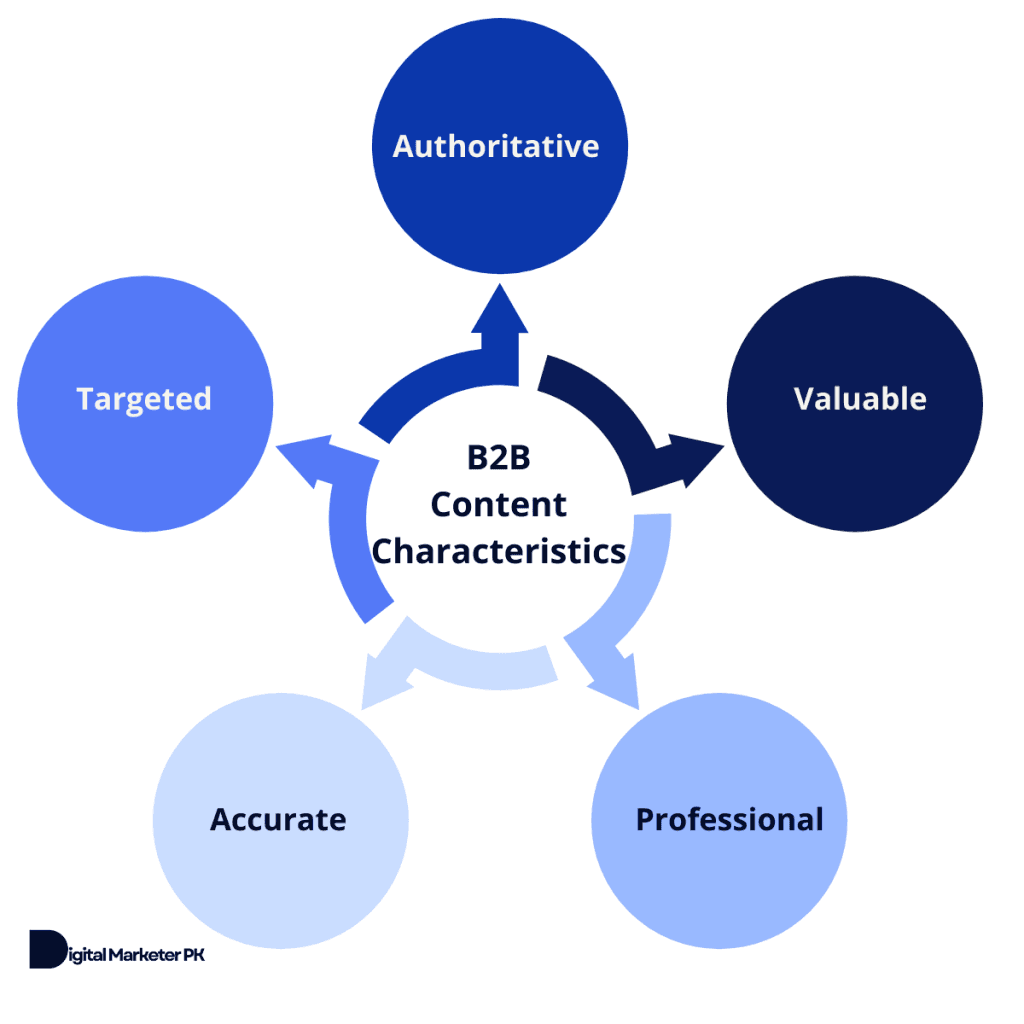
When a CMO is reading a blog post on an email marketing guide, he isn’t interested in email marketing definition, how to sign up for an email marketing platform, or how to create a newsletter.
He’s looking for solid, advanced guidance on how his business can leverage email marketing. He’s interested in email marketing platforms, what features to look for, how to integrate an email marketing platform with existing apps, etc.
How do you create such content?
Here’s how:
- Analyze existing top ranking content on the same keyword and figure out how you can do better
- Go in more depth than existing pieces
- Add visuals to improve content readability
- Fulfill search intent
- Assign content to the funnel stage and write accordingly
- Improve content formatting and visual appearance as it makes your content professional
- Make content scannable by writing short paragraphs and sentences, adding bullets, and highlighting key points
- Optimize content for search engines by following on-page SEO best practices.
5. Promote Content
Publishing content isn’t enough, it needs to be promoted.
And the best way to promote your content is by acquiring backlinks. The equation is simple: The more backlinks from unique domains you have to a web page, the higher it’ll rank in SERPs.
There’s no exception to this rule.
If you assume that publishing epic content will push it to the first page of Google and you’ll start getting heaps of organic traffic. It won’t happen – ever.
You can rank without backlinks but the probability is quite low. If you choose to rank without backlinks, your competition can outrank you easily by acquiring 1-2 quality links.
An analysis of 11.8 million Google search results revealed that the number one search result in Google has 3.8x more backlinks than the rest of the pages on the first page.
Another study by Ahrefs reported that pages with more referring domains get more organic traffic and rank for more keywords than pages without backlinks:
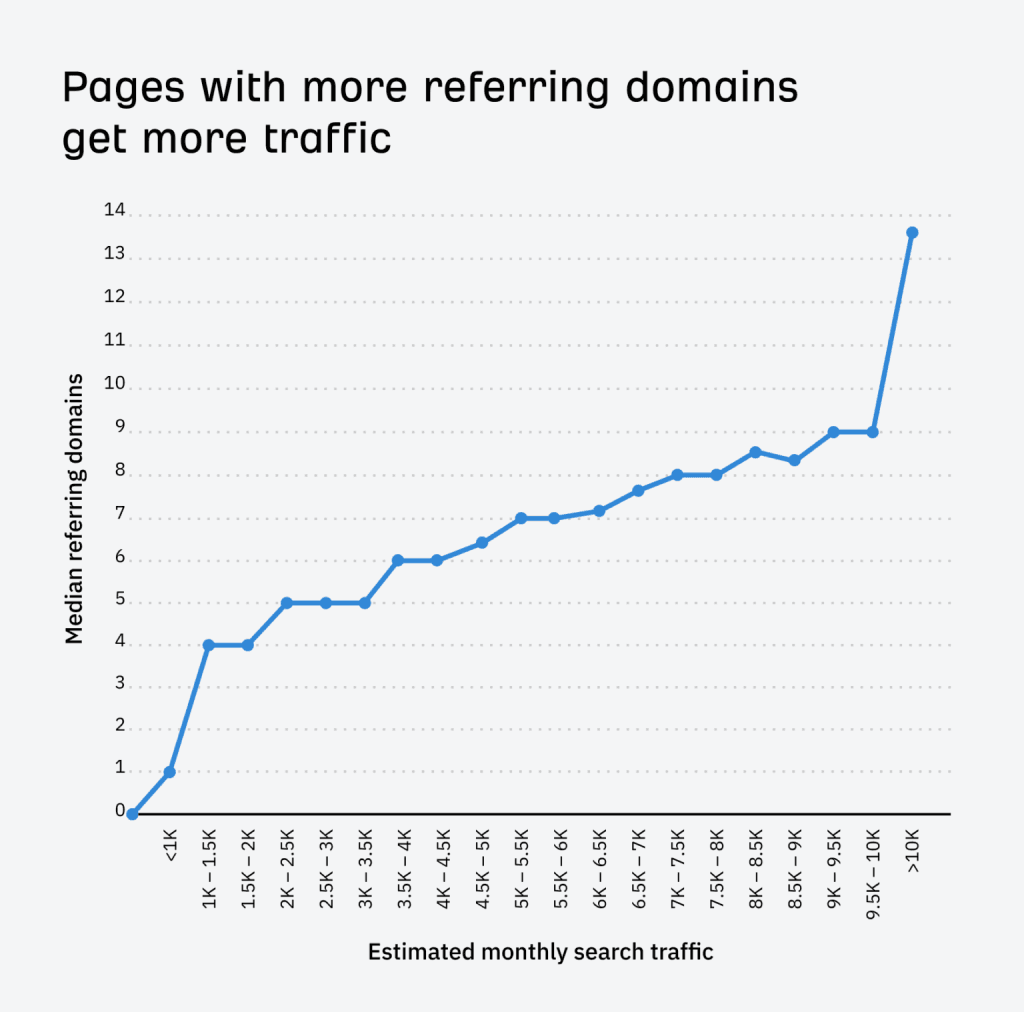
Ahrefs an experiment where they removed backlinks from 3 blog posts to see if removing them impact rankings. They removed 3,476 links from 3 blog posts and as soon as the links were disavowed for all the 3 posts, organic traffic and rankings declined significantly across all 3 posts.
Interestingly, when the disavowed file was removed (meaning backlinks were added back), the traffic spiked again (see Removed in the below image) but it didn’t reach previous organic traffic:
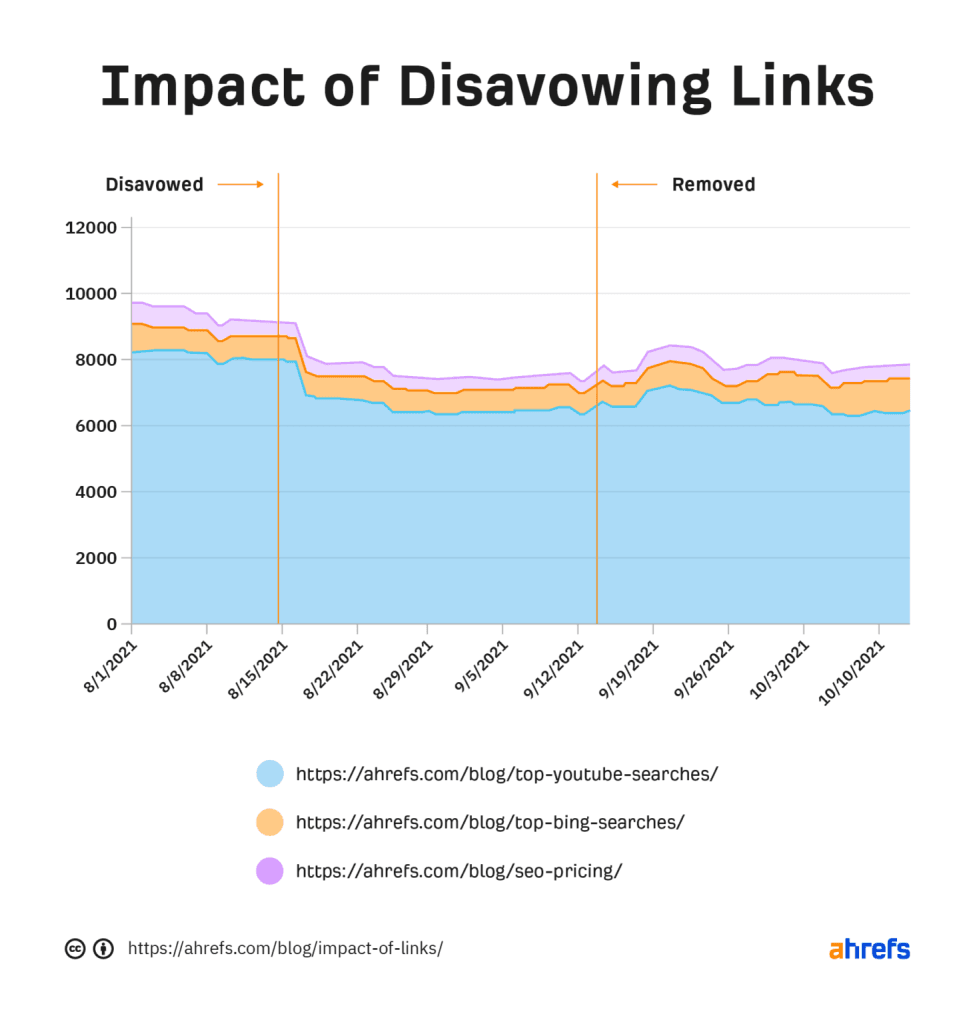
Backlinks are essential for your B2B SaaS SEO strategy and organic traffic. Here’s how to acquire white hat backlinks:
- Run a personalized outreach campaign for backlink acquisition. Reach out to blogs and websites that have linked to similar content and show them your content
- Use guest posting. This works best as it helps you get backlinks from relevant websites and you can drive referral traffic and boost brand awareness
- Ask business partners and your network to add a link to your SaaS on their website or a blog post
- Create link-worthy content that people like linking to. This includes infographics, charts and graphs, whitepapers, research studies, reports, etc.
- Use HARO where you can help reporters and bloggers as a source and get quality backlinks
- Look for resource pages and send in your resource. A lot of blogs publish links to helpful resources for their readers. You need to find relevant resource pages and send your content for inclusion.
The idea is to actively reach out and build connections. Almost all the link building techniques including manual outreach which is essential. You should reach out to blogs, influencers, and webmasters and show them your content – that’s how they’ll link to it.
6. Measure SEO Performance
You need to monitor progress, track performance, and make necessary adjustments in your SaaS B2B SEO strategy.
The first step is identifying suitable metrics to measure SEO performance. These are derived from the goal of your strategy.
For instance, if the objective of the B2B SaaS SEO strategy is to increase organic traffic, relevant metrics include organic traffic, keyword ranking, organic CTR, and others.
You need to track multiple metrics – not just one.
For instance, does an increase in organic traffic increase the organic conversion rate? Has it impacted customer acquisition cost?
A single or a few metrics won’t show you a complete picture. It’s best to use multiple metrics to track SEO performance.
Here’s a list of the most relevant SaaS B2B metrics for measuring SEO performance:
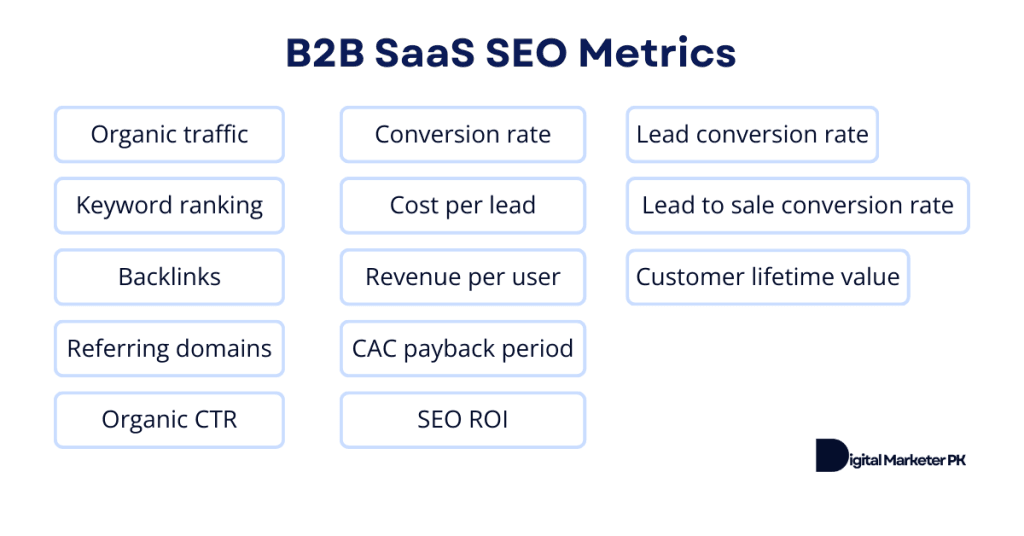
- Organic traffic
- Keyword ranking
- Number of backlinks
- Number of referring domains
- Organic CTR
- Organic conversion rate
- Lead conversion rate
- Cost per lead
- Lead to sale conversion rate
- Customer lifetime value
- Average revenue per user
- CAC payback period
- SEO ROI.
You don’t have to track metrics for the sake of measurement, rather, use these to tweak your SEO strategy. If something isn’t working as expected, figure out the issue, and fix it.
A B2B SEO Strategy for SaaS Business is a Must
Having a robust SEO strategy for your B2B SaaS company is an absolute must. It helps your brand in numerous ways that go beyond organic traffic.
Having an online presence increases brand awareness, trust, credibility, and authority.
The B2B SaaS SEO strategy steps shared in this article will help you get started immediately. Set clear goal, develop buyer personas, find keywords, create and promote content, and track performance.
If you need a helping hand, we are a click away.
Reach out to us and see how we can help you grow your B2B SaaS business with SEO.

